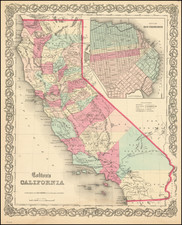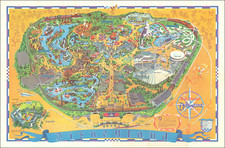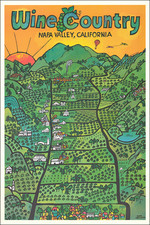Rare early bird's eye view of Alosta (Glendora), California from the south. The view shows the town less than 8 months after the founding of Glendora, in April 1887.
The view extends from Maunaloa Avenue in the foreground to Mountain View in the west, East Seventh Street in the east and Olive Avenue in the North. The center of town is Central Avenue. This plan grid can still be seen today. Mauna Loa Avenue, Walnut Avenue and Colorado Avenue still appear on the map. Alosta Avenue or Chestnut are now Route 66. Central Avenue would appear to be Glendora Avenue.
The primary image is a view from Alosta Heights looking over the town, with the railroad at the left, fruit orchards in distance and the San Gabriel Mountains beyond. The view includes inset views of the Rice Brothers Livery and Feed Stable, 2 different views of buildings on Central Avenue, S.C. (Southern California?) Hotel, a Cottage in the Le Mars Tract, the Railroad Depot, and the Residences of George E. Gard and P.O. Zeimet.
George E. Gard is the only person to have served as both police chief in Los Angeles, California, and sheriff of Los Angeles County. He was the city's fourth chief (December 12, 1880-December 10, 1881), succeeding Henry King, and the county's 16th sheriff (1884-1886), succeeding Alvan T. Currier. Gard came to California in 1859 with his Uncle, Henry Williamson. He served as 1st Sergeant of Company H., 7th California Volunteer Infantry, during the Civil War. After leaving the service, Gard settled in Wilmington for two years, then moved to Los Angeles, where he established the Los Angeles Ice Company, "the first to enter into that business in Southern California." In 1869 he married Kate A. Hammel. Of their children, two were surviving in 1889 - William Brant and Georgetta Miles. In 1871 Gard was appointed deputy county clerk for one year, then joined the Los Angeles Police Department as a detective for three years. In 1874 he became deputy county recorder and from 1875 to 1879 was chief recorder of the county.
In 1880 he was appointed chief of police of Los Angeles by the City Council. It was Gard who "fielded the first traffic squad in 1881, composed of an unknown number of officers, to 'horse, wagon and carriage' control to ensure pedestrian safety." Gard became a deputy sheriff, and in 1884 he was elected on the Republican ticket as the sheriff of the county. His term ended in 1886. As noted in An Illustrated History of Los Angeles County,
In 1886 Mr. Gard purchased forty acres of land at Gladstone and the next year a tract of land at Alosta [both in the San Gabriel Valley]. Soon after his purchase he commenced active operations in subdividing his lands and inviting the settlement of that section. Early in 1887, in connection with F. M. Underwood and S. Washburne, he incorporated the Alosta Land and Water Company. Mr. Gard was the president and general manager of the company, and he developed water in the Little Dalton Canyon and piped the same to that tract at an expense of about $25,000. The lands of the company found ready sale. He also sold a portion of his property at Gladstone, and was one of the prominent leaders in opening up the section in which he resided. In addition to his real-estate operations he devoted himself to horticultural pursuits. His present home is located about one-half mile east of Gladstone, where he is establishing one of the representative fruit industries of his section, having now (1889) fifteen acres of Washington Navel oranges and a large variety of deciduous fruits on his eighty-acre tract at that point. In addition to his home place he has a tract of 107 acres of hill and valley land, one-fourth of a mile south of Alosta, upon which there is a five-acre orange grove and a two-acre orchard of deciduous fruits. He also has lands on Citrus and Broadway avenues in the Gladstone tract, which is well improved and producing deciduous and citrus fruits, besides business and residence property in Alosta, including wood and coal yard, cottages, etc.
Glendora was once part of the Rancho San Jose. Ygnacio Palomares received the 22,000-acre land grant Rancho San Jose from Governor Juan Bautista Alvarado in 1837. The land included the present day cities of Pomona, Claremont, La Verne, San Dimas, and Glendora Located at the foot of the San Gabriel Mountains, modern Glendora was founded on April 1, 1887 by George D. Whitcomb who moved to California from Illinois in the early 1880s. Whitcomb was the founder of the Whitcomb Locomotive Works in Chicago and Rochelle, Illinois. He devised the name Glendora by combining the name of his wife, Leadora Bennett Whitcomb, with the location of his home.
OCLC locates only 2 known examples (Bancroft Library/UC Berkeley and Huntington Library).











![California [early appearance of Orange County!]](https://storage.googleapis.com/raremaps/img/small/96829.jpg)
![[California Wine Advertising Graphic] Italian Swiss Colony Producers of Choicest California Wines Asti Colony Tipo](https://storage.googleapis.com/raremaps/img/small/83467.jpg)

